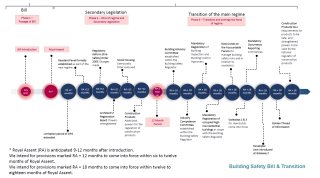Some of Dame Judith Hackitt's recommendations for building safety reform have been made but others have been pushed aside during the bill's passage through parliament.
The Building Safety Act 2022 enshrines in law the creation of the Building Safety Regulator, an office within the Health & Safety Executive to provide oversight of the new system with powers of enforcement and sanctions.
A Construction Products Regulator will also have powers to remove dangerous products from the market.
A New Homes Ombudsman will provide redress for dissatisfied buyers of new-build homes.
The Act also enshrines the requirement for a ‘golden thread’ of information for the storage and dissemination of all safety related matters in the design and construction of high-risk residential buildings. There are also new requirements on duty holders to have clear accountability and statutory responsibilities as buildings are designed, constructed and refurbished.
However, one of Dame Judith Hackitt’s key recommendations has been dropped during the passage of the legislation. Hackitt recommended the establishment of a new legal role of Building Safety Manager, to provide a single point of responsibility. The government included this in the draft bill but was persuaded to delete it on 22nd March during the passage of legislation after taking evidence that it would mean substantial extra cost for leaseholders.
Despite the Building Safety Act becoming law today, many of the provisions will not come into force for another 12 to 18 months, requiring secondary legislation and to prepare the industry for the new regime.
Eddie Tuttle, director of policy, external affairs and research at the Chartered Institute of Building, said: “We are pleased the Building Safety Bill has received Royal Assent to ensure building safety is a priority and to provide much needed accountability in the system. This provides long overdue certainty for the industry, though the next twelve to eighteen months will be crucial in preparing built environment professionals for the new roles and competencies that will be required.
“However, concerns remain that some of the recent amendments, such as removing the duty to appoint a Building Safety Manager, will lead to a lack of clarity over the right competencies and training for those in the ‘accountable persons’ role and potential inconsistency in the implementation of Building Safety management regimes.
“CIOB, in line with its public benefit mandate, will continue to play a vital role in supporting the quality and safety agenda. CIOB will also continue to collaborate with our sister professional bodies to help ensure the new arrangements are workable in practice and that the development of secondary legislation and guidance is fit for purpose.”

The Construction Industry Council (CIC), a forum representing most of the industry’s professional institutions, said that the Building Safety Act “represents a paradigm shift in the way in which residential buildings are to be designed, built, managed and regulated”. However, it said that the construction industry was not yet prepared for the culture change that the new legislation demands.
“There needs to be a considerable communication exercise to create the necessary culture change in the industry and to absorb the new regulatory regime,” the CIC said.
While welcoming the 262-page Act, which has taken two years since the publication of a draft bill in 2020, CIC said it had reservations about the extensive changes made during the passage of the bill. In particular, the holistic process recommended by Dame Judith Hackitt’s Building a Safer Future report has been “cherry-picked”, the CIC said.
The last-minute change of heart about the statutory requirement to appoint a Building Safety Manager is a prime example of this break from the Hackitt recommendations. The role has been removed but the functions to ensure the building safety of residents remain and the idea that the cost of providing building safety management of occupied buildings, in scope to the Act, will not fall on the residents is unlikely to be the case, irrespective of whether there is a duty to appoint a Building Safety Manager, the CIC said.
The council is also concerned about the impact of extended liability under the Act – extending the period of liability under the Defective Premises Act from six to 30 years “is unworkable for practical and contractual reasons”, CIC said. “This amendment is likely to further exacerbate an already uncertain market for professional indemnity insurance.”
It added: “The PII market for construction-related activity in general and any work on high-rise residential buildings, in particular, is already far too weak to meet demand and there is adequate data to show that businesses are leaving the marketplace as a result. This is a major problem that requires urgent government intervention to enable businesses to continue to be able to carry out work on the design, construction and management of high-rise residential buildings and more widely, on fire risk and building safety work. Taken together with the rising cost of building work, particularly in relation to construction product availability and inflation, this will have a constraining impact on the industry’s ability to meet housing demand, especially affordable housing. This is a matter that the Treasury will need to consider very carefully.”
Further information about the requirements of the Building Safety Act 2022 can be found at
www.gov.uk/government/publications/building-safety-bill-factsheets

Got a story? Email news@theconstructionindex.co.uk
.png)


